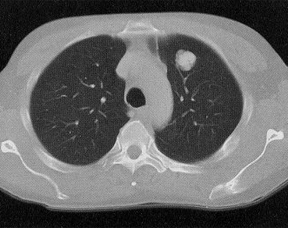Low ctDNA Levels are Prognostic of Outcomes in Early-Stage Lung Adenocarcinoma
The NeXT Personal platform identified minuscule amounts of ctDNA that were found to be predictive of OS and RFS outcomes in patients with lung adenocarcinoma.
The NeXT Personal platform identified minuscule amounts of ctDNA that were found to be predictive of OS and RFS outcomes in patients with lung adenocarcinoma.

NeXT Personal, an ultrasensitive, whole-genome-based, tumor-informed circulating tumor DNA (ctDNA) detection platform, was able to identify tiny amounts of ctDNA that predicted less favorable clinical outcomes and reduced survival compared with patients who are ctDNA-negative with early-stage lung adenocarcinoma, a study published in Nature Medicine reported.1
In an analysis of 171 patients with early-stage lung cancer from the observational TRACERx study (NCT01888601), ctDNA was discovered pre-operatively in 81% of patients with lung adenocarcinoma, of which 53% of those patients had pathological pTNM stage I disease.
Additionally, ctDNA status was predictive of overall survival (OS) in patients with lung adenocarcinoma (ctDNA low: HR, 11.08, 95% CI, 1.48-83.2; ctDNA high: HR, 19.33; 95% CI, 2.56-146.0) and relapse-free survival (low: HR, 14.17, 95% CI, 1.91–105.3; high: HR, 25.79, 95% CI, 3.48–191.4). Patients with a preoperative ctDNA negative score (n = 18) had improved 5-year OS results compared with patients who are ctDNA low (n = 38) and patients who are ctDNA high (n = 38), 100% (95% CI, 100%-100%) compared with 61.4% (95% CI, 47.3%-79.6%) and 48.8% (95% CI, 34.7%-68.7%), respectively.
Patients were deemed to be ctDNA low if their ctDNA levels were below the median of those detected and ctDNA high if their levels were above the median of those detected.
“Lung cancer is one of the most common types of cancer in the UK, but it’s hard to treat with a high relapse rate,” Charles Swanton, FRCP, BSc, PhD, medical oncologist at University College London Hospitals, deputy clinical director and head of the Cancer Evolution and Genome Instability Laboratory at the Crick, chair in personalized cancer medicine at the UCL Cancer Institute, chief investigator of the TRACERx study, and senior author of this study, stated in a press release.2 “It’s vital to understand who would benefit from more aggressive treatment, especially for patients with stage I disease who are often diagnosed during CT screening for those at a higher risk. Using sensitive ctDNA tests is one way to do this, which we hope will maximize clinical benefit and minimize unnecessary treatment for individual patients.”
Patients in the TRACERx study were required to be 18 years or older with early-stage IIA to IIIB disease and histopathologically confirmed non–small cell lung cancer who had primary surgery in keeping with National Institute for Health and Care Excellence (NICE) guidelines, an ECOG performance status of 0 or 1, and a minimum tumor diameter of at least 15mm.3
Patients were excluded if they had other malignancy diagnosed that is currently being treated, psychological condition that precludes informed consent, treatment with neoadjuvant therapy for current lung malignancy deemed necessary, known human immunodeficiency virus, hepatitis B virus, hepatitis C virus or syphilis infection, and if post-surgery staging is not IIA to IIIB.
The NeXT Personal platform detects ctDNA in the blood at 1 to 3 ppm (.0001%-.0003% tumor fraction) with an estimated specificity of 99.9%.
For patients without lung adenocarcinoma, preoperative ctDNA levels were far less predictive of outcomes; ctDNA levels greater than the median in patients with lung adenocarcinoma were not indicative of reduced RFS (HR, 1.81; 95% CI, 0.93-3.92; P = .077).
The authors also noted that, in patients whom ctDNA would not have been reliably detected using the approach from the TRACERx study, ctDNA at levels below 80 ppm was prognostic for poor OS (HR, 12.33; 95% CI, 1.63-93.35; P = .0029) and RFS (HR, 18.07; 95% CI, 2.41-135.3; P = .00011) in patients with lung adenocarcinoma.
“In this study, these patients with detectable but extremely low levels of ctDNA experienced a worse clinical outcome than those in whom we did not detect evidence of ctDNA,” the authors of the study wrote.1 “This suggests that there is a subset of [patients with very-low-risk] with lung adenocarcinomas who can be definitively identified only by using an ultrasensitive and specific assay to be used prognostically for escalation of therapy in stage I lung adenocarcinoma exhibiting ctDNA release.”
Reference
- Swanton C, Black JRM, Bartha G, et al. Ultrasensitive ctDNA detection for preoperative disease stratification in early-stage lung adenocarcinoma. Nat Med. (2025). doi:10.1038/s41591-024-03216-y
- Tumour DNA in the blood can predict lung cancer outcome. News release. The Francis Crick Institute. January 13, 2025. Accessed January 13, 2025. https://tinyurl.com/44ymea2d
- Tracking non-small cell lung cancer evolution through therapy (Rx) (TRACERx). ClinicalTrials.gov. Updated February 10, 2023. Accessed January 13, 2025. https://tinyurl.com/vepp5hdn